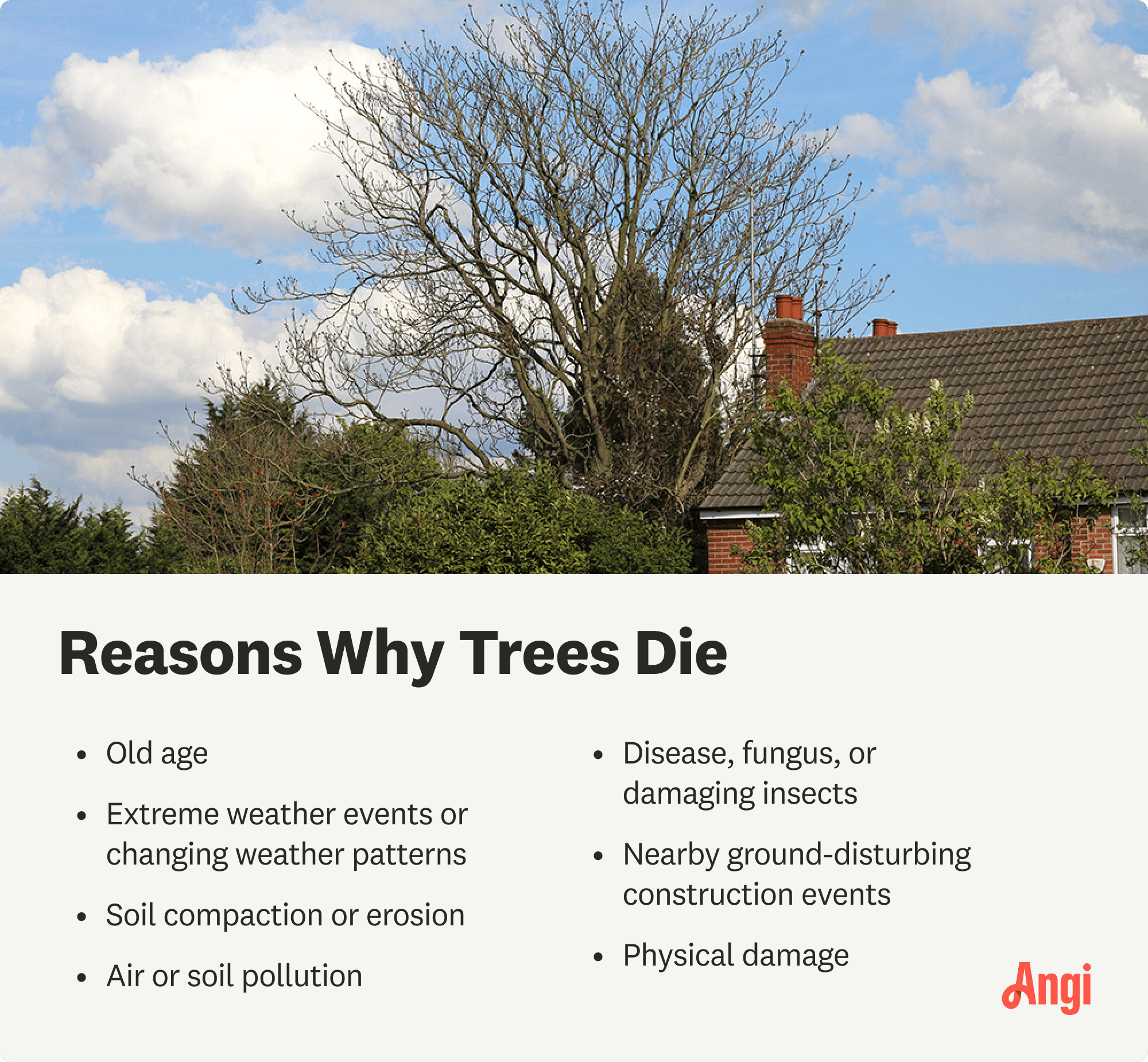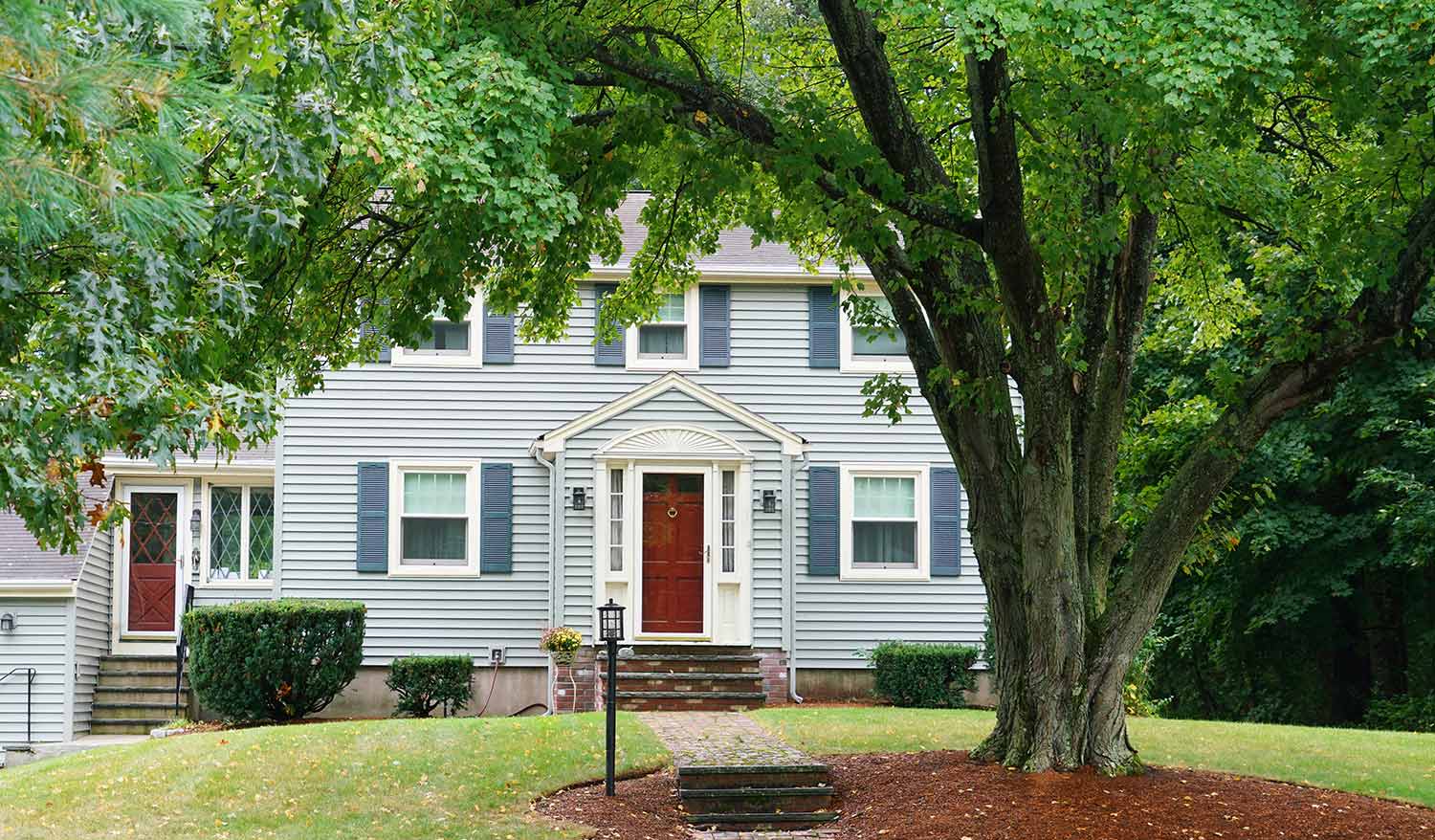
Find out how much it costs to plant a tree based on the number of trees, their size, where you want to plant them, and DIY versus professional costs.
Look for common signs that your tree is dead


You can spot a dying tree by checking its physical appearance.
Check the tree's leaves, bark, branches, and roots.
Look for fungi, mushrooms, and pests.
Call in a pro as soon as possible to evaluate any dying trees.
Whether from old age, pests, disease, or a lack of resources, even the most spectacular trees can see an unfortunate decline. Knowing how to tell if a tree is dead is important, as dead trees can harbor termites and other pests, or become a serious fall or fire hazard. In some cases, noticing symptoms early may even make it possible to save a dying tree. These are the top signs a tree is dying or dead.

Deciduous trees shed their leaves every winter, falling dormant for the season. If they fall or turn from lush and green to brittle or brown in the warmer months, that may signal a problem, according to Tara Dudley, owner of Plant Life Designs. "Be sure to keep an eye out for yellowing leaves, too.”
Additionally, declining deciduous trees may have dead leaves that don’t fall off in the wintertime. For example, coniferous evergreen trees are usually green throughout the year. If they turn brown at the tips or have yellow or red hues, they may be stressed or dying.
Finding leaves with black spots doesn’t mean your tree is necessarily dying, but you need to treat it as it signifies a fungal or bacterial infection.
Healthy trees have the occasional dead branch or twig, but if you notice more than usual on the ground, it’s time to investigate. To test your tree’s health, grab a twig and bend it between your fingers. If the limb is flexible and bends, all is well. But if the twig easily snaps, the branch is dead.
All trees have one or two dead branches; however, several large, dead branches are a sign that your tree is dying. Dead branches and tree limbs can fall without warning and cause property damage, injury, and even the death of your tree.
Apical Buds are located at the tips of a tree’s branches and look like a small, scaly cone and where the branch grows. They will be dried out or no longer there if the tree is dying or dead. Inspect the buds to determine whether your tree is dead, and consider calling a local arborist for a confirmation check.

If bark is loose and falling off, if an area on the tree trunk is bare, or there are deep cracks in the bark, this may also signal a problem. Note that some types of trees naturally shed bark, including crepe myrtle, sycamore, and river birch trees.
Perform the scratch test—scratch the bark or branches with your fingernails or a knife. Healthy bark will be moist and green inside. If it is brittle and brown underneath, your tree may be dying.
A tree’s trunk supplies water from the roots to all of its branches and leaves. Cavities, cracks and splits, and missing bark on a tree’s trunk are signs of a potential health issue.
Severe weather can also damage trees, leaving open wounds like large cuts, cracks, and torn branches. Lightning strikes will also show in bald patches or long streaks on the trunk. All of these events can eventually kill a tree.
Fungi, which may be tan, orange or red, thrive off of dead wood. Mushrooms growing at the base of the tree can eat away at the roots, while fungi on the trunk may indicate that the tree’s insides are rotting (or already rotted).
Some fungi are treatable with fungicides, or a local tree maintenance professional may be able remove the affected limbs. However, some are not. For example, if you see whitish or silvery scales, then the tree likely has Hypoxylon canker, which cannot be treated.
If your tree is dying, you may find common pests like termites, bark beetles, and carpenter ants are the cause of the problem.
Some types of termites feed on live trees, weakening branches and making them susceptible to falling off. Signs of a termite infestation include tree shavings at the base of the trunk, dead termite bodies, white eggs, mud tubes, and small holes in the tree.
Bark beetles are the size of a grain of rice and are brown or black, and can be found under loose bark. Pitch tubes, small, different-colored tubes on the tree, are proof it has been attacked by bark beetles. If the tubes are white, the tree was able to repel the beetles, but if they are reddish brown, the beetles likely won the battle. Beetles can also transfer the oak wilt fungus to oak trees.
Carpenter ants can be found inside hollow areas of trees or in cracks. Larger than common household ants, they are dark brown or black and can be wingless or winged. If there’s an infestation, you’ll find sawdust-like material near the tree’s base or there may be a hollow sound inside the tree, which indicates the presence of a nest.
A myriad of issues can stem from the roots, including brown and wilted leaves, dead branches, and lack of foliage. Construction, excavation, or even a heavy storm can damage shallow or exposed roots—check for small sprouts popping out from the base of the trunk.
"Other issues affecting the tree caused by the roots could be from planting," says Dudley. "If the tree was planted too deep initially, the roots could also be girdling the trunk of the tree, causing it to decline slowly."

Take a few steps back to look at the whole tree. If you notice it’s leaning to one side, that could indicate there’s a problem with the roots. A tree won’t be able to stay upright if the roots are weakened or damaged. Check to see if the roots are separating from the ground, as this is another symptom that the tree isn’t stable.
If you suspect that your tree is dying, the best thing you can do is to hire a tree maintenance professional near you. If you spot some tree issues or diseases early enough—for example, sudden oak death or fire blight disease—then there’s a chance that you can bring the tree back to full health.
On the other hand, there’s a chance that your tree may be too sick to make a recovery. In these instances, the best thing to do is to hire a tree removal pro to cut it down, as it can fall over and cause damage to your home. It can also be a conduit for spreading diseases to healthy trees or turn into a home for termites.
From average costs to expert advice, get all the answers you need to get your job done.

Find out how much it costs to plant a tree based on the number of trees, their size, where you want to plant them, and DIY versus professional costs.

The cost of tree stump removal depends on size, removal method, location, and more. Our guide will show you how much stump removal costs.

Trimming your bushes is one of the less costly aspects of landscaping, and it’s helpful to bundle many trimming services together to save money.

Tree stumps can take a long time to die and become suitable for removal. You can help out by applying Epsom salt and vinegar, a homemade option that works with patience.

Learn how to move a palm tree while avoiding irreparable damage. Using these steps to transfer a palm tree to a new spot.

Grinding a tree stump requires a chainsaw, heavy-duty equipment, and a strategy for cleaning up debris. Keep reading to learn how to use a stump grinder.